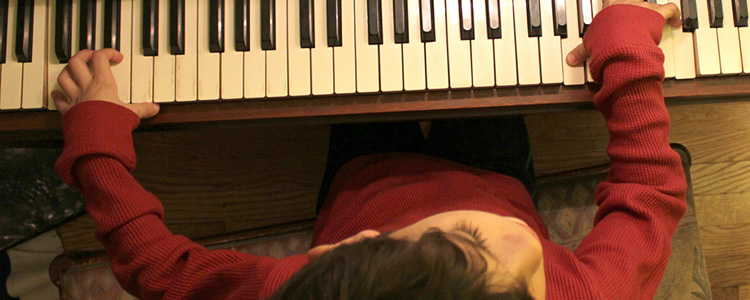For Lightning Speed, Prodigious Memory, Phenomenal Multitasking, See A Musician

woodleywonderworks via flickr | http://bit.ly/VgSa6F
Image rights: http://bit.ly/NL51dk
(Inside Science) -- Even old jokes can have a scientific basis in fact.
You know the one about the tourist who stops a native New Yorker on the street and asks, "Excuse me sir, but how do you get to Carnegie Hall?"
"Practice, practice, practice."
That New Yorker is absolutely correct. Scientists have found that the brains of professional musicians are physiologically different from the brains of other people, and they got that way mostly because of practice, practice, practice.
Training "turbo hands"
They can move fast, seemingly faster than humanly possible. For instance, when classical pianist Anna Fedorova plays the popular Piano Concerto No. 2 by Rachmaninoff, her fingers and hands will sometimes move so fast they almost cannot be seen. Meanwhile, all ten fingers are hitting every particular key in just the right way and she has all the 26,000 or so notes memorized. Now in her early 20s, she has been practicing the piano since the age of five.
Some musicians can play more than one melody at a time. Vladimir Horowitz, as an encore, would often play a piano version of John Phillip Sousa's Stars and Stripes Forever march, ending with his left hand doing the melody and his right hand, in seemingly impossible counterpoint, doing what is usually the piccolo part, an entirely different melody.
It is not just classical pianists who can exhibit opposing or unrelated motions simultaneously. So can jazz musicians like Keith Jarrett, and violinists such as Nadja Salerno-Sonnenberg. Her right hand does the bowing while her left hand modifies the sound of the strings, an entirely different motion, and she can do it at lightning speed.
And if it looks as though they are in a trance or autopilot when they are performing, they probably are.
How did they get to be able to do that? Yes, practice.
Repurposing the hands
Repetition of movement helps both the ability to move faster and precisely as well as the multitasking involved in playing some instruments. Musicians are, in a way, fighting nature. The default position of the human hand is holding a rock, not bowing a violin, said Alan Hugh David Watson, a reader in biosciences at Cardiff University in Wales.
For one thing, the ability to move with almost superhuman speed is a bit of an optical illusion, Watson said. The musicians surely are going fast, but their fingers are not moving very far, a centimeter or two for the violin, he said. He also said that while piano beginners put a great deal of pressure on the fingers, with practice pianists learn to use only the minimum amount needed for each note, an economy of energy, making it easier for the hands to fly across the keys.
It is "absolutely possible" to teach people to move quite fast, said Sharon Levy, who teaches at the Juilliard School of Music in New York, and the Peabody Institute in Baltimore. "It's a combination of natural ability, practice and good teaching."
It also is possible to train musicians to play two voices simultaneously. In fact, some music was written just to teach children how to do it, including Johann Sebastian Bach's Inventions. The Three-Part Inventions are more complicated than the Two-Part, and those get more complicated as they go on. Bach was the master of the fugue, where one melodic idea, or voice, on one hand is followed by the same idea on the other, only later, like a round.
"People can learn to play counterpoint, though they vary in skills," Levy said. “For pianists this is basic. We don't start off with a Bach fugue, of course."
Bach even has inversions, with one hand doing one thing and the other the exact opposite. Some people come at it more naturally than others, she said.
Nature or nurture?
With practice, musicians can eventually perform on autopilot, a trance, or meditation. They are not thinking of what they are playing. ("That would screw things up," Watson said.) They enter a different realm, and if you sit close enough you can see them do it.
Some, like Salerno-Sonnenberg, make inadvertent grimaces while playing. The best example may be the late Glenn Gould, a master of Bach who was clearly in another world when he played, crouched over the keyboard, his mouth moving as he was talking to the keys, gently urging them on. He can occasionally be heard to grunt on his recordings. Jarrett moans and vocalizes as well.
Many musicians play with their eyes closed and still never get a wrong note.
Watson once saw a woman violinist's neck glow bright red when she played, a condition he called "pre-orgasmic."
What is crucial, Watson said, is the kind of practice. Folklore among musicians is that you need 10,000 hours of practice to excel, but Watson said how you practice is more important than how long.
It has to be intense and the player single-minded. You are essentially programming your brain to train the muscle memory. You have to play perfectly in practice so the brain knows only one way to play the piece and you don't have to make decisions while you play.
"It is incredibly tiring," Watson said. Many break up practice sessions into small pieces and there is scientific evidence that catnaps between sessions actually help imprint the music.
"It is clear that sophisticated motor skills are developed only at the expense of a great deal of time and effort," he said.
The famous cellist Pablo Casals was once asked why, at the age of 93, he still practiced three hours a day.
"I'm beginning to see some improvement," he said.
Coming tomorrow: Why Musicians' Brains Are Different

